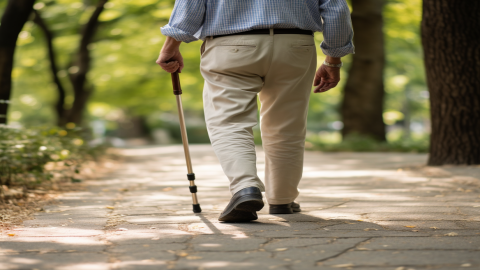Why does unsteady walking occur after a fracture?
Generally, unsteady walking after a fracture may be caused by factors such as muscle atrophy, decreased balance function, poor fracture healing, joint adhesion, or nerve damage. It is recommended to seek timely medical attention, identify the underlying cause, and undergo symptomatic treatment under a doctor's guidance. Detailed explanations are as follows:

1. Muscle Atrophy: Prolonged immobilization of the limb after a fracture leads to disuse atrophy of the muscles, causing weakness and instability during walking. This may also be accompanied by limb thinning and fatigue. Under a doctor's approval, early limb functional exercises such as muscle contraction training and joint range-of-motion exercises should be initiated. Gradually increase the amount of exercise, and massage can also be used to improve blood circulation and help restore muscle strength. Medication is generally not required.
2. Decreased Balance Function: Long-term bed rest after a fracture prevents adequate training of the body's balance system, resulting in reduced balance ability. This causes instability during walking, with swaying gait, especially noticeable during initial attempts to stand and walk. Begin standing exercises near the bed and gradually transition to walking with support from a wall. Use tools such as balance pads for progressive balance training. Walking stability will gradually improve as balance function recovers.
3. Poor Fracture Healing: Improper alignment or slow healing of the fracture can cause unequal limb length or abnormal weight distribution, leading to instability while walking due to shifted center of gravity. This may also be accompanied by localized pain and swelling. Regular X-ray follow-ups are necessary to assess fracture healing. If healing is delayed, medications such as bone peptide tablets, Jiugu Qili tablets, or calcium carbonate D3 tablets may be used as directed by a physician to promote healing. In cases of severe malunion, open reduction and internal fixation surgery may be required to correct the fracture position and restore normal limb alignment.
4. Joint Adhesion: Prolonged immobilization after a fracture can cause adhesion of joint capsules and ligaments, limiting joint mobility and causing unsteady gait. Symptoms may also include joint stiffness and pain during movement. Under the guidance of a rehabilitation specialist, joint mobilization exercises should be performed. Heat application and physical therapy can also help loosen adhesions. If necessary, surgical release of joint adhesions may be performed to improve joint mobility.
5. Nerve Injury: Injury to surrounding nerves during a fracture can lead to abnormal sensory or motor function, reducing muscle control and causing unsteady walking. This may also be accompanied by numbness and tingling in the limb, with more severe symptoms corresponding to more significant nerve damage. In cases of nerve transection, nerve anastomosis surgery is required to restore nerve continuity, followed by postoperative rehabilitation training to regain function.
Daily rehabilitation training should be conducted under the guidance of a doctor or rehabilitation specialist to avoid excessive activity that might interfere with fracture healing. Increase intake of protein, calcium, and vitamins in the diet, such as from eggs, milk, and fresh vegetables, to promote bone and muscle repair. Use assistive devices like crutches while walking to reduce the risk of falls, and gradually wean off them as function improves.








